A B2B SEO Strategy for 2024
Alastair Kane Search Marketing, Search Marketing PartnerRead it in 29 minutes
Read it in 29 minutes
Table of contents
B2B SEO, also known as Business-to-Business SEO, involves optimising a website and its content to attract and engage businesses. This strategy differs from B2C SEO, which targets consumers with different needs and preferences.
Generally, SEO can be divided into the following categories:
B2B buyers are different from B2C for several reasons:
These characteristics of the B2B buyer influence the approach needed for a successful B2B SEO strategy, which focuses heavily on building brand awareness and gaining the trust of the target audience through thought leadership content.
Online interactions are becoming increasingly important in B2B purchases.
In fact according to Gartner, by 2025, 80% of B2B sales interactions between suppliers and buyers will occur in digital channels.
In this increasingly online world, a business’ website needs to become an effective sales channel containing content that helps B2B buyers in their journey to purchase.
It could be argued that the website is now on an equal footing in terms of impact, as the Sales Development Rep (SDR).
A 2019 Gartner Survey, reported that B2B buyers used sales reps and websites in more or less equal measure when considering a purchase.
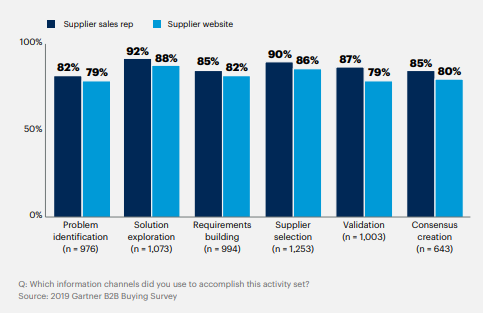
In addition to this, Millennials, being the first digitally native generation, are increasingly becoming more involved in purchase decisions, meaning the scales are tipping in favour of further website usage during the sales process.
In fact 44% of millennials prefer no contact with a sales rep in a B2B interaction.
What does all this mean?
Online channels, such as SEO are going to become increasingly important in the next few years as a means to influence a B2B purchase.
It is important to consider how AI might impact B2B SEO in the future. Google announced the introduction of Search Generative Experience (SGE) in May 2023 in beta to a few select countries. SGE provides AI-powered snapshots (as shown in the image below) that display information to the searcher on the fly, so they don’t have to leave the Google ecosystem. Think of it like an AI version of the featured snippet.
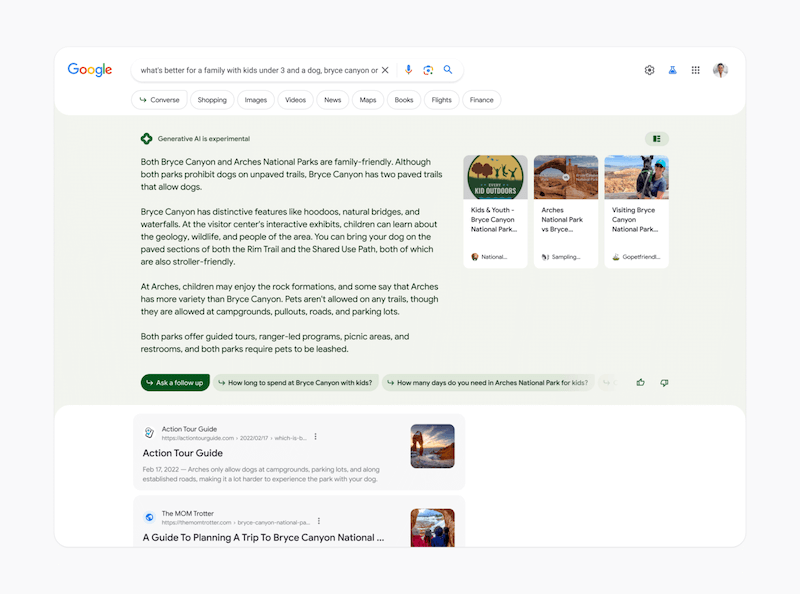
The announcement sent shock waves through the SEO community as it would threaten the efficacy of some standard B2B SEO tactics that have worked well for years. However, at the time of writing this post in February 2024, SGE is still very much in beta and not available in the UK.
AI is an important consideration for modern B2B SEO. In the future we may need to rethink certain strategies, especially concerning the current best practice of having a pillar page targeting broad topics that tend to have higher volumes. Informational keywords are at risk from AI, but until SGE is out of beta, nobody truly knows what the SEO landscape will look like a few years from now.
SEO, by its very nature, tends to sit higher in the funnel and most keywords won’t have buying intent behind them.
The real value of B2B SEO is in generating brand awareness for a business in organic search.
This occurs primarily through content optimised for the so-called ‘long tail’ of search. These are informational keywords that wouldn’t provide ROI if targeted with paid search.
So if SEO works best when generating awareness and doesn’t deliver traffic (in the main) with buyer intent, wouldn’t precious marketing budget be better spent on other digital marketing channels?
Yes, perhaps.
It depends on the priorities of the business.
SEO needs to be viewed as a long term business investment that will pay dividends further down the road.
Dividends such as band awareness in Google for topics that your target audience is searching for.
Brand awareness generates trust and trust eventually generates sales.
But for a small business that has just started trading, I would argue that SEO is likely not a priority as the focus should be on trying to get the business off the ground. I would recommend trying some paid search advertising (PPC) to get page 1 visibility for your buyer keywords. PPC will also provide valuable keyword data which can be used in an SEO strategy, once the business is turning a profit.
To view SEO in isolation to other channels often leads to judging its effectiveness solely in terms of keyword rank and organic traffic.
In reality SEO works in conjunction with, and compounds the impact of other channels.
Just think of your own buyer behaviour.
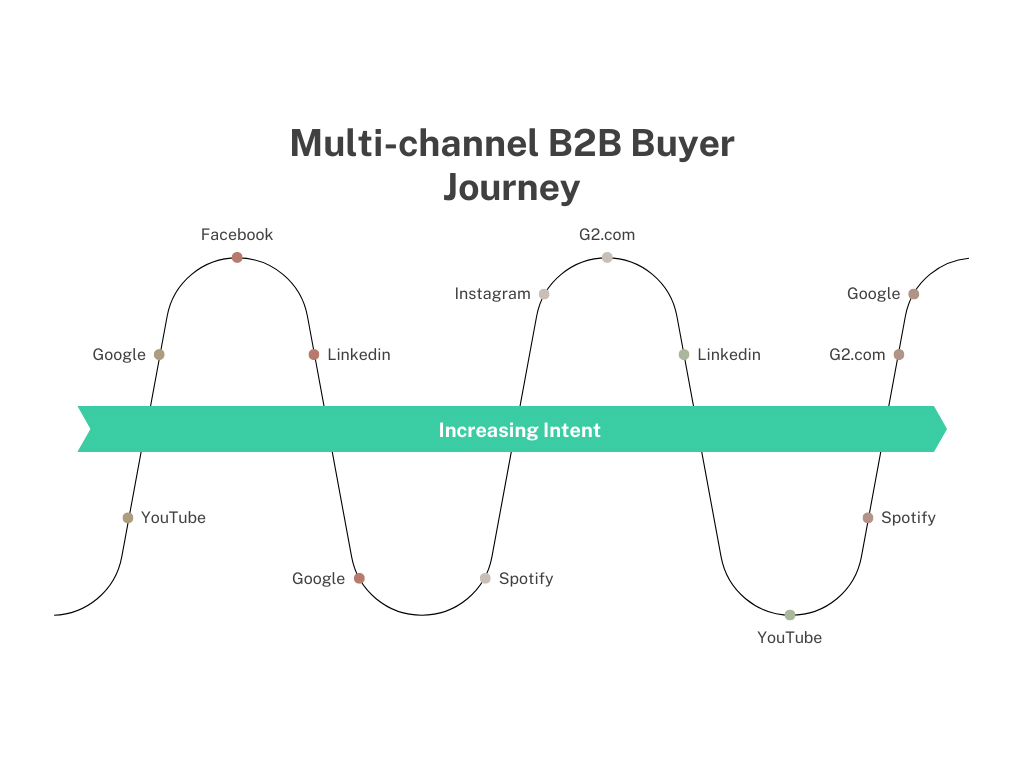
You get the picture!
Google will very rarely be the only touchpoint on a journey to purchase.
It is unlikely that a B2B buyer will follow a linear process, use Google, click to visit a website and buy all in one session.
.The diagram below illustrates what is more likely to happen.
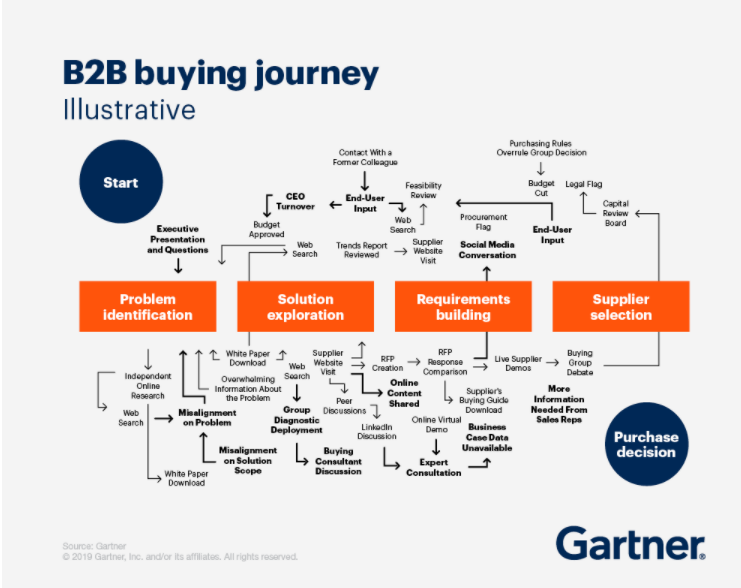
In 2019 Gartner posited that the B2B buying journey doesn’t follow a linear path through the traditional sales funnel.
Instead of stages happening sequentially, they suggested they happen simultaneously across a number of stakeholders.
So when planning an SEO campaign, it is important to consider how organic fits in with other channels and understand that metrics like keyword rank and organic traffic don’t paint the full picture.
In fact, I would argue that the real value of SEO is in growing brand awareness which builds trust which in turn drives revenue.
For example, consider a CMO who is looking to buy a new CRM platform.
She first lands on brand X’s website and reads a blog post.
A week later she views a video on brand X’s YouTube channel.
After that, on a visit to G2 Crowd viewing their review of top 10 CRMs, she sees brand X listed.
She then returns to brand X’s website by Googling the brand name, and signs up for a demo.
The initial blog post in question may have been ranking no.1, but its influence in the CMO’s decision to purchase is far more valuable.
It was a key factor in building brand trust within a multi-channel buyer journey that eventually led to a demo.
The following 7 steps cover all the key elements needed in an effective strategy. I have left out technical SEO here because it is a topic that is complex in its own right and will be the subject of a separate post.
The 7 steps below assume the website already has a solid SEO health foundation.
Let’s dive in!
The cornerstone of good B2B marketing is to know who your target customers are and the challenges they’re looking to solve.
What goals do they have in their professional capacity?
SEO is no different.
Sure we have keyword tools and data to help inform SEO strategy, but nothing quite beats talking to your customers to first understand why they bought from you.
And if you can’t talk to your customers, talk to your sales team. They are on the front line and can provide a wealth of information regarding customer pain points.
Joining a few calls that sales are having with prospects will also give you valuable insight into the pain which incentivised them to initially visit the website and book a call.
I find that the free persona templates you find online are only useful to a certain degree and often include questions that aren’t relevant with regard to creating a successful B2B SEO strategy.
Here is a customer questionnaire template which you can use to define your target persona. It outlines key information which will help in the creation of the strategy.
The main output of this first step, is to provide information to input into Step 2 – Keyword Research.
We are looking to obtain the following to inform the keyword research process:
Now that you have a clear understanding of who your target customer is and what challenges they face in their work roles, you will need to gather data on keywords they use.
It is helpful to approach keyword research using Total Addressable Market (TAM) principles, so by the time this step is completed, we have an idea of the total natural search opportunity for your business.
This will leave us with an extensive library of keywords to inform a full funnel content strategy.
Use the data sources outlined below, in conjunction with keyword research tools, to gather all search terms and topics that are relevant to your target customer.
The customer interviews, along with any insight your sales team has given, will provide you with search queries that real prospects are using.
This information is gold.
You will also have collected information from relevant websites and forums your prospects visit.
Visit these websites and note down any relevant keywords of interest.
Do the following with each keyword you collect.
This process can be illustrated like this:
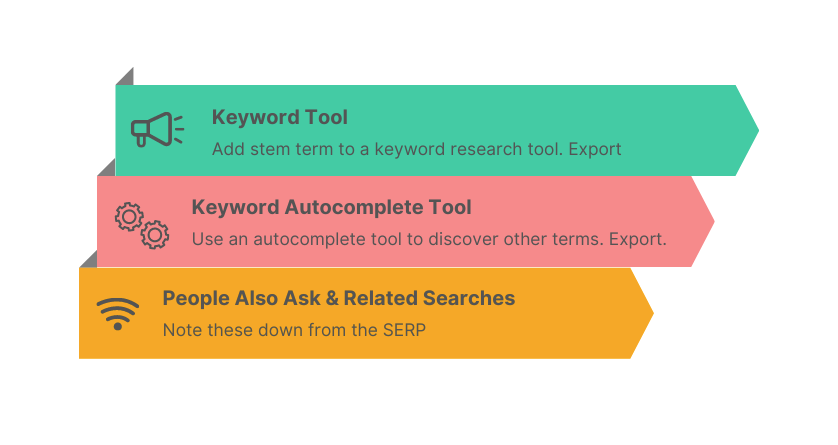
Google Search Console provides valuable information on keywords that people are typing into Google, that trigger your website in the search results.
If you haven’t set up Google Search Console yet, here is a guide on how to do this.
This valuable keyword information is found under ‘Performance’ in the left hand menu.

Make a note of any relevant keywords you find and follow the same 3 step process as before.
Researching competitor websites is another source of keywords to inform your B2B SEO strategy. Looking at results in the top 10 can provide clues as to what Google’s algorithm thinks is worthy of ranking on page 1. If you can emulate and improve upon their strategy, you will have a strong chance of appearing on page 1 of the search engine results.
I suggest paying closer attention to the underdogs in the top 10 – sites that don’t have much SEO authority. A low authority site on page 1, in a sea of big players, means they have nailed their SEO marketing efforts and is definitely worth closer inspection to find out what they are doing.
This process of collecting seed keywords from customer interviews, Google Search Console and competitors, will result in an extensive keyword library that will form an SEO strategy to capture and generate demand in the search engines for your products and services.
You should now have a large list of relevant keywords in spreadsheets.
In order to make sense of the data, the keywords need to be organised.
The first thing to do is to sort the keywords in terms of:
Your keyword research will have produced a broad range of terms relevant to your target customer, not all of which will be directly related to the products and services your business offers.
Organising keywords according to the following categories, will give clarity on what the priority terms for the business are.
As a B2B SEO Consultant, here are examples of what Priority, Supplemental and Emerging keywords would be for me:
Once keywords have been allocated, the content strategy should be proportioned in the following way:
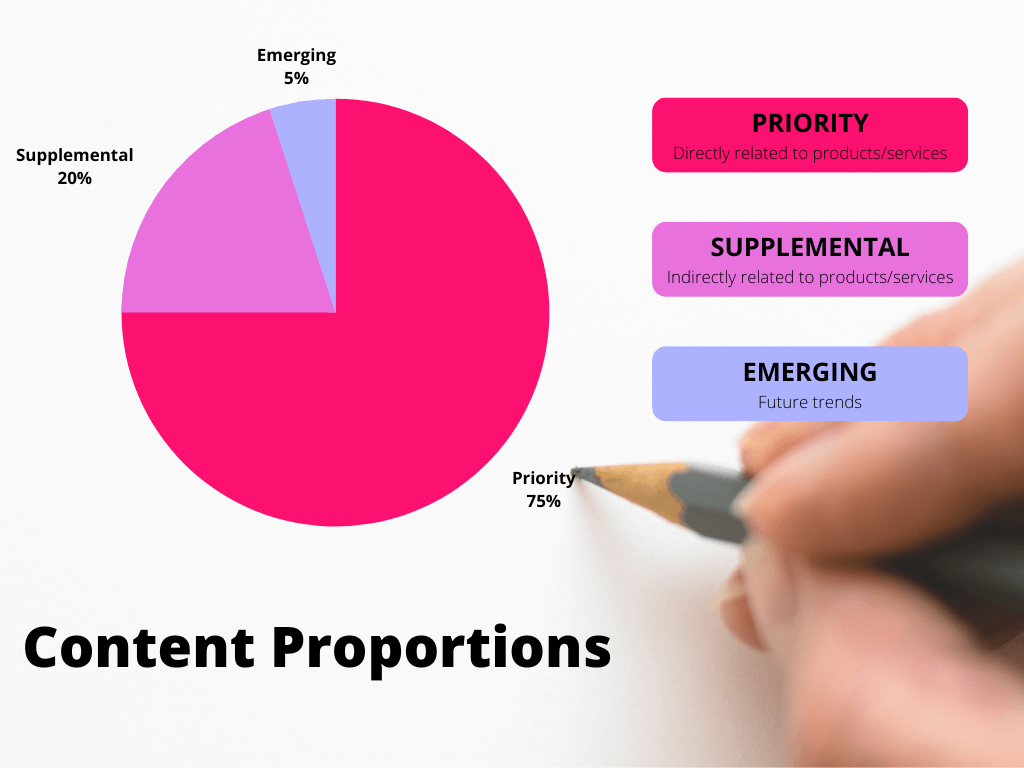
This ensures that blog content covers a good mix of topics, maximising chances that the website is visible in search whenever potential customers are searching for information relating to their job role.
Aligning content with user intent (search intent) is a big part of ranking high in Google.
If you take a look at Google’s own Search Quality Guidelines, you will see that the phrase ‘user intent’ is mentioned 100s of times throughout the document.
User intent is simply the reason why they are conducting a search and can be categorised as follows:
Finally each keyword must be looked at in terms of how difficult it would be to gain a page 1 position.
Looking down our list of keywords, we want to highlight those that have the right mix of relevance, low keyword difficulty and a good monthly search volume (MSV).
Most standard SEO tools such as SEMRush, Ahrefs etc, will have their own version of keyword difficulty, but they all equate to the same thing – how difficult it would be to rank highly.
Highlighting keywords with good search volume and low difficulty will show opportunities where your site can rank on page 1 with a relatively small effort.
Here is a link to an example keyword list template which outlines how keywords should be organised in terms of:
The MSV and Keyword Difficulty columns have been colour formatted to indicate opportunity, with green representing a favourable opportunity.
This makes is easy to see at a glance any quick wins where you can focus on keywords that have relatively high search volume and low difficulty ie 2 greens.
Now that you have completed these first two ‘research’ steps you have a strong, data backed foundation on which to build a B2B SEO strategy, designed to attract the right type of visitor to your website.
You’ll now have an extensive library of possibly 1000s of keywords, organised and ready to use.
In Step 3 your goal is to ensure that the website is set up and optimised so it’s visible to people in search with intent to purchase.
This is achieved by optimising key pages, such as the homepage and product/service pages, with the transactional keywords we discovered in Step 2.
You need to make sure that these pages are set up to capture existing demand in search for the products and services your business offers.
When it comes to on page optimisation, here are some considerations to bear in mind:
The main points regarding on page optimisation have been covered above, but for further information on this topic, see here.
On completing Step 3, the homepage and product/service pages will be optimised for product focused keywords that will capture existing demand.
In the next step we will look at generating new demand for your products and services.
This is accomplished by devising a B2B content strategy that focuses on increasing visibility in search for Informational and Investigational keywords.
Relevant content is the beacon which attracts prospects to your site, in search of answers to questions they have.
The aim of your content should be to offer help and answer these questions.
And not sell.
Because B2B buyers are in control of the sales process.
Using content to push for a sale, or a call or demo or whatever, is becoming increasingly ineffective , as buyers become more savvy to these outdated practices.
Your content should be like a non-pushy salesperson in a shop. They are there if you have any questions, but will leave you alone to browse and make your own decisions in your own time.
According to TrustRadius, 87% of B2B buyers want to self-serve part or all of their buying journey.
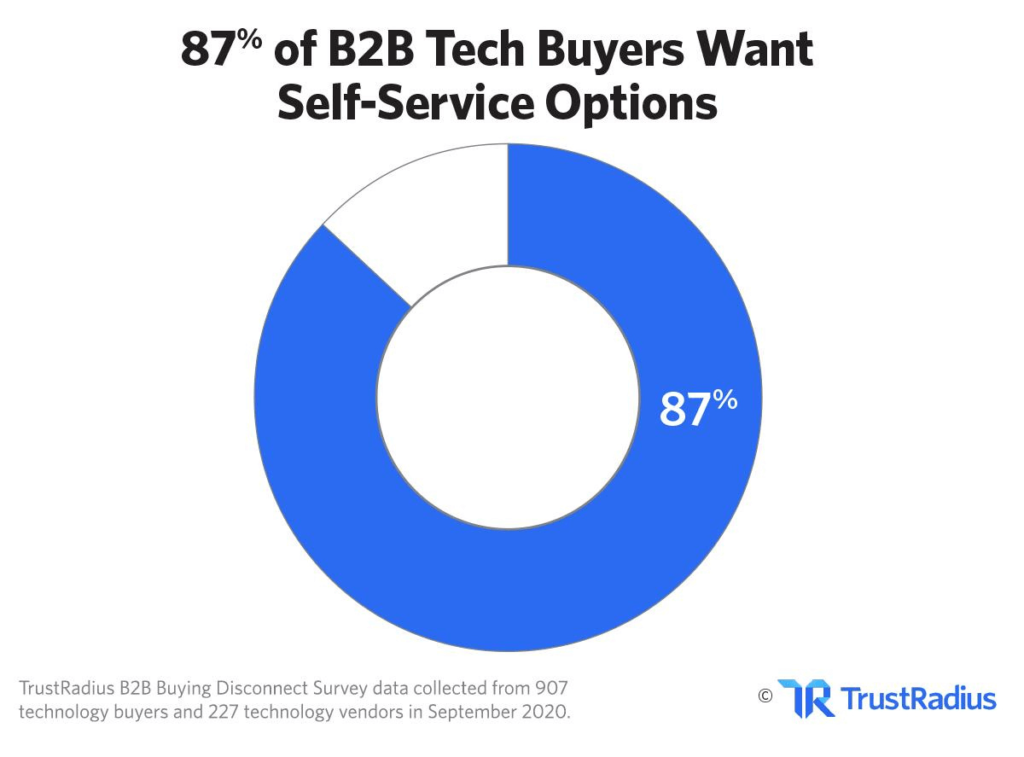
And 57% of buyers have already made a purchase decision before even talking to a vendor representative.
The importance of valuable content can’t be underestimated. It is the fuel needed for the organic growth of your business.
Once keywords have been organised as described in Step 2, you are now in a position to begin structuring a content calendar.
Planning your content in quarterly sprints is recommended.
And at the end of each sprint, do a cohort analysis of the content you’ve published in the preceding quarter, to determine how successful it has been.
This analysis will provide the insight necessary to strategically plan the next 3 months of content.
Here are some recommendations for content creation:
Click here for a more in depth look at creating a B2B content strategy for a SaaS business.
Backlinks are still an important factor that Google takes into consideration when ranking pages.
Links to a page essentially act like votes of confidence that measure how trustworthy and authoritative the linked to page is.
All other things being equal, the more backlinks a page has, the more organic visibility it will earn.
However, not all links are created equal, and there have been successive Google algorithm updates over the years to curb manipulative link building practices.
A tool or calculator that benefits your prospects is an excellent way to attract links naturally, as well as drive more relevant traffic to the site.
If you are stuck for ideas on what type of tool to create, refer back to the Persona Questionnaire from Step 1.
This should have revealed a number of customer pain points that you can use for ideas when designing a new tool.
There will obviously be some upfront investment with this tactic, but it will pay dividends in the long run in terms of traffic and links.
And it will give you an edge over your competition who are likely to be using tactics that are easier to replicate.
Has your business been featured on other websites?
Perhaps your CEO has been interviewed in an online article which mentions your business, but isn’t linked back to the website?
These unlinked brand mentions are ideal opportunities to easily build quality backlinks to the site.
As the website is already mentioning your brand, it should be relatively easy asking the site owner to add a link.
How to find unlinked brand mentions
Here are a couple of ideas you can use to help find unlinked brand mentions:
Guest blogging provides an opportunity to get your content published on a 3rd party website.
The link generally comes from the author bio accompanying the article.
This link building tactic can be a contentious issue amongst SEOs. Despite that, I’m including it anyway as it works.
If it is carried out with the right goals in mind.
The right approach to guest blogging is to go beyond focusing on the potential link and consider how a piece of content on an external website could increase brand awareness to your target audience.
Remember SEO is a channel for increasing brand awareness which in turn builds trust.
If you had a chance to be featured on a leading industry website would you even care about the link as long as you got a brand mention?
I doubt it.
When executing a guest blogging strategy consider whether or not the site is one that your prospects would visit.
Anticipate how the guest blog site could benefit your brand and business.
This leads nicely onto Step 6.
SEO is primarily a brand awareness channel making it the ideal partner of digital PR.
Whereas SEO draws brand awareness internally towards a website, the outlook of digital PR is external, promoting a brand off-site.
Like its traditional counterpart, digital PR is focused on gaining exposure for a brand, but digitally.
Brand exposure is achieved through a variety of methods with campaigns which involve promoting newsworthy content that:
Key to making a digital PR campaign successful is coming up with an interesting angle for a story or topic that a journalist would like to explore further.
Think of it as helping a journalist out with a piece that comes from a unique perspective and which they wouldn’t necessarily have time to research themselves.
Here are some ways that will help you to get in touch with journalists looking for a story.
Help a Reporter Out (HARO) has been around since 2008 and is a service which provides journalists with a database of expert sources they can use for stories.
Follow these steps to use HARO in digital PR campaigns:
Qwoted works in a similar fashion to HARO and is another site where journalists can connect with expert sources.
Additionally, Qwoted has powerful filtering options that help journalists select sources based on geography, gender and many other characteristics, so sources can be chosen to reflect an audience.
Profnet is owned by Cision, the same organisation which owns HARO.
How does it differ from HARO?
Profnet, which is a subsidiary of PR Newswire, is used for getting mentions in press releases, whereas HARO is for stories.
Think of OnePitch as the tech focused alternative to HARO.
This is the perfect digital PR tool for B2B tech businesses, providing a means to pitch to journalists that cover stories on technology.
You can also connect with journalists on Twitter by searching #journorequests.
Journalists use this hashtag when searching for expert sources prior to writing a piece.
So it is certainly worth checking this out regularly to see if there are journalists interested in covering a story related to your industry.
One could argue that digital PR falls under the umbrella of ‘off-site SEO’, which primarily includes link building.
But Digital PR is so much more than simply building links and isn’t the key metric that is measured in campaigns.
Increased brand searches and organic traffic are far more important, with links being a welcome consequence of an effective strategy.
Digital PR and SEO complement each other leading to greater overall brand exposure on and off the website.
And greater brand awareness generates trust which in turn leads to sales.
They say a goal without a plan is just a wish.
I would add that a goal without a plan and regular feedback is also just a wish.
Without regular reporting and analysis to assess how your B2B SEO strategy is helping to push towards agreed KPIs, you will not know whether it is working and will have little insight into any changes required to ensure it is working towards agreed business objectives.
Doing a quarterly analysis of what content is working and not working, will provide vital feedback needed to plan the next quarter’s content.
The following will need to be looked at:
After all the quarter’s scheduled content has been published perform a cohort analysis by following these steps:
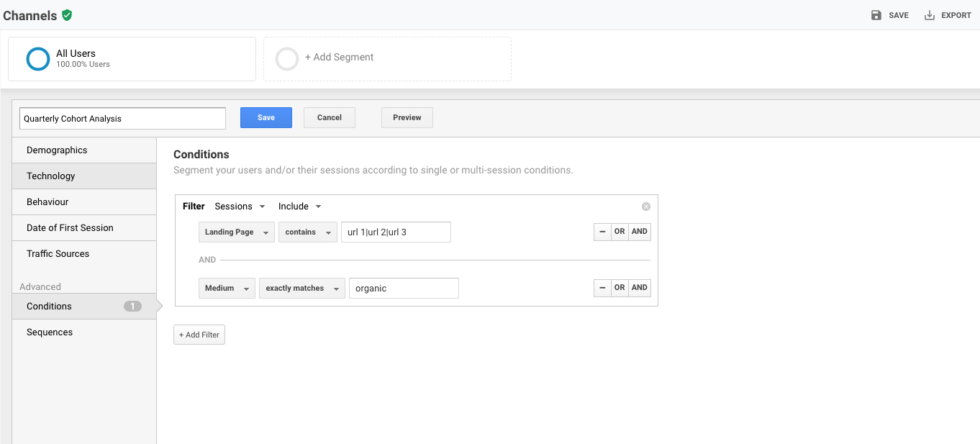
Setting this up will enable you to easily see Google Analytics data for the content you publish over a quarter.
What you should be looking for in your analysis are any outliers in the engagement data, as we want to create more content that shows strong engagement.
For instance, if you saw that ‘top tips’ type blogs resulted in good visitor engagement, you might want to consider more of these in the next quarter’s content.
The engagement metrics to focus on are:
I have excluded Bounce Rate here as it will tend to be high for blog content anyway.
In addition to looking at engagement metrics in Google Analytics, check where content is ranking.
If it isn’t ranking on page 1, your content is invisible for most search users.
So you will need to do one or more of the following to address this issue:
In addition to performing a quarterly analysis of content performance, I would also strongly recommend a content refresh at least once a year.
The goal of a yearly refresh is to look at content that is declining in terms of organic traffic and rank over time.
Content performance naturally deteriorates over time for the following reasons:
Content deterioration results in Google Analytics traffic data that looks like this:

Any content which is declining in terms of SEO performance should be examined and assessed with the following questions in mind:
If you have exhausted all the above and you still have trouble ranking in search, your website may have low authority and in need of a link building campaign.
Or perhaps there are serious Technical SEO issues that need to be addressed.
Let’s travel back in time about 20 years.
Back then the majority of small to medium sized businesses may have been questioning the need to even have a website.
You may have heard comments from internet Luddites like:
“We don’t acquire customers online, so why bother with a website”
“I can’t see how a website can really help our business as we are a business that services customers at a physical premises”
“I can understand why a website might be useful, but it just isn’t a priority right now”
Today most businesses will accept that a website is necessary as part of their marketing strategy.
However, many businesses are slow to move past the idea of a website being little more that an online presence.
This is evidenced in the type of content some businesses publish on their sites which is often very company-centric and doesn’t appeal to the needs of target customers.
For B2B businesses, a website should be viewed as a channel that can deliver leads and sales.
Hopefully this post will have provided you with a plan on how you can transform your business website into an online beacon that attract prospects looking for answers to challenges that your business can solve.
If you would like an SEO consultation to talk about how I can help your B2B business, get in touch to arrange a call.
Sign up to receive B2B Search Marketing Insights direct to your inbox
Book a call to discuss your business' search marketing needs
Book a call